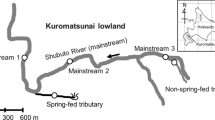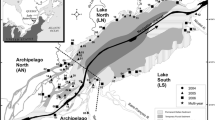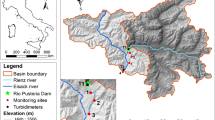Abstract
Limestone (karst) springs within the River Wye catchment (Derbyshire, U.K.) were investigated to examine the influence of physical and chemical characteristics and habitat variability on macroinvertebrate community composition. Flow permanence had a greater influence on the invertebrate community than any other physical or chemical variable examined. Clear differences in the macroinvertebrate community were observed between perennial (7) and intermittent springs (11) and the mainstem river. Springs support distinct communities, with some taxa exclusively recorded at the source or within the springbrook (e.g. Agabus guttatus [Paykull] and Micropterna lateralis [Stephens]). A degree of faunal overlap with the mainstem river occurred suggesting that perennial springs may form a refugium for many taxa and that intermittent springs are rapidly colonised by taxa from the mainstem river after the resumption of flow.
Similar content being viewed by others
References
Boulton, A. J. & P. S. Lake, 1992. The ecology of two intermittent streams in Victoria, Australia. II. Comparisons of faunal composition between habitats, rivers and years. Freshwat Biol. 27: 99–121.
Crichton, M. I., 1971. A study of caddis flies (Trichoptera) of the family Limnephilidae, based on the Rothamsted Insect Survey 1964–68. J. Zool. Lond. 163: 533–563.
Danks, H. V. & D. D. Williams, 1991. Arthropods of springs, with particular reference to Canada: synthesis and needs for research. Mem. Entomol. Soc. Can. 155: 203–217.
Delucchi, C. M. & B. L. Peckarsky, 1989. Life history patterns of insects in an intermittent and a permanent stream. J. n. am. Benthol. Soc. 8: 308–321.
Denis, C., 1978. Larval and imaginal diapauses in Limnephilidae. In Crichton, M. I. (ed.), Proceedings of the Second International Symposium on Trichoptera, July 1977, Reading, England. DrW. Junk Publishers, The Hague: 109–115.
Dittmar, H., 1955. Ein Sauerlandbach. Arch. Hydrobiol. 50: 305–552.
Edmunds, W.M., 1971. Hydrogeochemistry of Groundwaters in the Derbyshire Dome with Special Reference to Trace Constituents. Report 71/7, Institute of Geological Sciences. HMSO, London: 52 pp.
Elliott, C. R. N., M. J. Dunbar, I. Gowing & M. C. Acreman, 1999. A habitat assessment approach to the management of groundwater dominated rivers. Hydrol. Process. 13: 459–475.
Erman, D. C. & N. A. Erman, 1984. The response of stream macroinvertebrates to substrate size and heterogeneity. Hydrobiologia 108: 75–82.
Erman, N. A. & D. C. Erman, 1995. Spring Permanence, Trichoptera Species Richness, and the Role of Drought. J. Kans. Entomol. Soc. 68: 50–64.
Feminella, J. W., 1996. Comparison of benthic macroinvertebrate assemblages in small streams along a gradient of flow permanence. J. n. am. Benthol. Soc. 15: 651–669. 57
Ferrington, L. C. Jr., R. G. Kavanaugh, F. J. Schmidt & J. L. Kavanaugh, 1995. Habitat separation among Chironomidae (Diptera) in Big Springs. J. Kans. Entomol. Soc. 68: 152–165.
Fischer, J., 1996. Bewertungsverfahren zur Quellfauna. Crunoecia 5: 227–240.
Fischer, J., F. Fischer, S. Schnabel, R. Wagner & H. W. Bohle, 1998. Die Quellfauna der hessischen Mittelgebirgsregion. Besiedelungsstruktur, Anpassungsmechanismen, und Habitatbindung der Makroinvertebraten am Beispiel von Quellen aus dem Rheinischen Schiefergebirge und der osthessischen Buntsandsteinlandschaft. In Botosaneanu, L. (ed.), Studies in Crenobiology: The Biology of Springs and Springbrooks. Backhuys Publishers, Leiden: 183–199.
Foster, G. N., 2000. A Review of the Scarce and Threatened Coleoptera of Great Britain: Part 3 Aquatic Coleoptera. Joint Nature Conservation Committee, Peterborough: 226 pp.
Friday, L. E., 1988. A Key to the Adults of British Water Beetles. Field Studies 7: 1–151.
Glazier, D. S., 1991. The fauna of North American temperate cold springs: patterns and hypotheses. Freshwat. Biol. 26: 527–542.
Glazier, D. S. & J. L. Gooch, 1987. Macroinvertebrate assemblages in Pennsylvania (U.S.A.) springs. Hydrobiologia 150: 33–43.
Gooch, J. L. & D. S. Glazier, 1991. Temporal and spatial patterns in mid-Appalachian springs.Mem. Entomol. Soc. Can. 155: 29–49.
Gordon, N. A., T. A. McMahon & B. L. Finlayson, 1992. Stream Hydrology: An introduction for ecologists. JohnWiley and Sons, Chichester: 526 pp.
Gunn, J., 1998. The Hydrogeology of the Carboniferous Limestone in the Derwent Catchment. Report for the Environment Agency. LRG Report 98/13: 37 pp.
Gunn, J., P. Hardwick & P. J. Wood, 2000. The invertebrate community of the Peak-Speedwell cave system, Derbyshire, England–pressures and considerations for conservation management. Aquat. Conserv.: Mar. Freshwat. Ecosyst. 10: 535–369.
Gunn, J., D. Lowe & T. Waltham, 1998. The Karst Geomorphology and Hydrogeology of Great Britain. In Daoxian Y. & L. Zaihua (eds), Global Karst Correlation. Science Press and VSP BV, 1998.
Hayford, B. & S. J. Herrmann, 1998. Migration patterns of four macroinvertebrates along a rheocrene thermal spring. In Botosaneanu, L. (ed.), Studies in Crenobiology: The Biology of Springs and Springbrooks. Backhuys Publishers, Leiden: 75–84.
Hoffsten, P.–O. & B. Malmqvist, 2000. The macroinvertebrate fauna and hydrogeology of springs in central Sweden. Hydrobiologia 436: 91–104.
Hogg, I. D. & D. D. Williams, 1996. Responses of stream invertebrates to a global warming thermal regime: an ecosystem-level manipulation. Ecology 77: 395–407.
Jefferson, G. T., 1976. Cave Faunas. In Ford, T. D. & C. H. D. Cullingford (eds), The Science of Speleology. Academic Press, London: 359–421.
Johnson, I. W., C. R. B. Elliott & A. Gustard, 1995. Modelling the effect of groundwater abstraction on salmonid habitat availability in the River Allen, Dorset, England. Regul. Rivers: Res. Manage. 10: 229–238.
Langton, P. H. & J. Casas, 1998. Changes in chironomid assemblage composition in two Mediterranean mountain streams over a period of extreme hydrological conditions Hydrobiologia 390: 37–49.
Laperriere, J. D., 1994. Benthic ecology of a spring-fed river of interior Alaska. Freshwat. Biol. 32: 349–357.
Lindegaard, C., J. Thorup & M. Bahn, 1975. The invertebrate fauna of the moss carpet in the Danish spring Ravnkilde and its seasonal, vertical, and horizontal distribution. Arch. Hydrobiol. 75: 109–39.
Malicky, H., 1989. Life cycle strategies of some European caddisflies. Proceedings of the sixth international symposium on Trichoptera, January 1998; Chiang Mai, Thailand: 195–197.
Mattson, R. A., J. H. Epler & M. K. Hein, 1995. Description of Benthic Communities in Karst, Spring-Fed Streams of North Central Florida. J. Kans. Entomol. Soc. 68: 18–41.
Meyer, A. & E. I. Meyer, 2000. Discharge and macroinvertebrates in a temporary karstic stream. Aquat. Sci. 62: 216–231.
Miller, J. D. & A. L. Jr. Buikema, 1977. The effect of substrate on the distribution of the spring form (Form III) of Gammarus minus Say. Crustaceana 4: 153–163.
Moubayed, J., P. H. Langton & E. Morello, 2000. On some chironomid populations from permanent and temporary springs, streams and pools in southern France: distribution and biogeographical significance. In Hoffrichter, O. (ed.), Late 20th Century Research on Chironomidae: and Anthology from the 13th International Symposium on Chironomidae. Shaker Verlag, Aachen: 571–577.
Nielsen, A., 1942. über die Entwicklung und Biologie der trichopteren. Arch. Hydrobiol. 17: 255–631.
Notenboom, J., S. Plènet & M. J. Turqin, 1994. Groundwater Contamination and its Impact on Groundwater Animals and Ecosystems. In Gibert, J., D. L. Danielopol & J. A. Stanford (eds), Groundwater Ecology. Academic Press, London: 477–504.
Petts, G. E., M. A. Bickerton, C. Crawford, D. N. Lerner & D. Evans, 1999. Flow management to sustain groundwaterdominated stream ecosystems. Hydrol. Process. 13: 497–513.
Pitty, A. F., 1976. Water temperatures of the limestone areas of the central and southern Pennines. Proceedings of the Yorkshire Geological Society 40: 601–612.
Pritchard, G., 1991. Insects in thermal springs. Mem. Entomol. Soc. Can. 155: 89–106.
Sear, D. A., P. D. Armitage & F. H. Dawson, 1999. Groundwater dominated rivers. Hydrol. Process. 13: 255–276.
Sket, B., 1999. The nature of biodiversity in hypogean waters and how it is endangered. Biodiv. Conserv. 8: 1319–1338.
ter Braak, C. J. F. & P. Šmilauer, 1998. CANOCO Reference Manual and User's Guide to Canoco for Windows: Software for Canonical Community Ordination (version 4). Microcomputer Power, Ithaca, NY, U.S.A.: 352 pp.
van der Kamp, G., 1995. The Hydrogeology of Springs in Relation to the Biodiversity of Spring Fauna: A Review. J. Kans. Entomol. Soc. 68: 4–17.
van Everdingen, R. O., 1991. Physical, Chemical and Distributional Aspects of Canadian Springs. Mem. Entomol. Soc. Can. 155: 7–28.
Wallace, I. D., B. Wallace & G. N. Philipson, 1990. A Key to the Case-Bearing Caddis Larvae of Britain and Ireland. Scientific Publication No. 51, Freshwater Biological Association, Ambleside: 237 pp.
Webb, D. W., M. J. Wetzel, P. C. Reed, L. R. Phillippe & M. A. Harris, 1995. Aquatic Biodiversity in Illinois Springs. J. Kans. Entomol. Soc. 68: 93–107.
Webb, D. W., M. J. Wetzel, P. C. Reed, L. R. Phillippe & T. C. Young, 1998. The macroinvertebrate biodiversity, water quality, and hydrogeology of ten karst springs in the Salem Plateau Section of Illinois, U.S.A. In Botosaneanu, L. (ed.), Studies in Crenobiology: The Biology of Springs and Springbrooks. Backhuys Publishers, Leiden: 39–48.
Williams, D. D., 1991a. The spring as an interface between groundwater and lotic faunas and as a tool in assessing groundwater quality. Int. Ver. Theor. Angew. Limnol. Verh. 24: 1621–1624.
Williams, D. D., 1991b. Life history traits of aquatic arthropods in springs. Mem. Entomol. Soc. Can. 155: 63–87.
Williams, D. D., 1996. Environmental constraints in temporary fresh waters and their consequences for the insect fauna. J. n. am. Benthol. Soc. 15: 634–650.
Williams, D. D. & H. B. N. Hynes, 1976. The ecology of temporary streams I. The fauna of two Canadian streams. Int. Rev. ges. Hydrobiol. 61: 761–787.
Williams, D. D. & N. E. Williams, 1998. Invertebrate communities from freshwater springs: what can they contribute to pure and applied ecology? In Botosaneanu, L. (ed.), Studies in Crenobiology: The Biology of Springs and Springbrooks. Backhuys Publishers, Leiden: 251–261.
Williams, D. D. & N. E. Williams, 1999. Canadian Springs: postglacial development of the invertebrate fauna. In Batzer, D. P., R. Rader & S. A. Wissinger (eds), Invertebrates in Freshwater Wetlands of North America: Ecology and Management. John Wiley and Sons, New York: 447–467.
Williams, D. D., N. E. Williams & Y. Cao, 1997. Spatial differences in macroinvertebrate community structure in southeastern Ontario in relation to their chemical and physical environments. Can. J. Zool. 75: 1404–1414.
Williams, N. E., 1991. Geographical and environmental patterns in caddisfly (Trichoptera) assemblages from coldwater springs in Canada. Mem. Entomol. Soc. Can. 155: 107–124.
Wright, J. F., P. D. Hiley, D. A. Cooling, M. E. Wigham & A. D. Berrie, 1984. The invertebrate fauna of a small chalk stream in Berkshire, England, and the effect of intermittent flow. Archiv. Hydrobiol. 99: 176–99.
Zollhöfer, J. M., 1999. Spring biotopes in Northern Switzerland: Habitat Heterogeneity, Zoobenthic Communities and Colonization Dynamics. PhD Thesis, Swiss Federal Institute of Science and Technology, Zürich.
Author information
Authors and Affiliations
Rights and permissions
About this article
Cite this article
Smith, H., Wood, P. Flow permanence and macroinvertebrate community variability in limestone spring systems. Hydrobiologia 487, 45–58 (2002). https://doi.org/10.1023/A:1022932303652
Issue Date:
DOI: https://doi.org/10.1023/A:1022932303652




